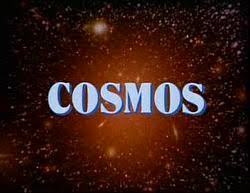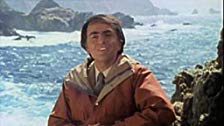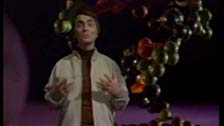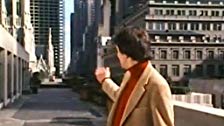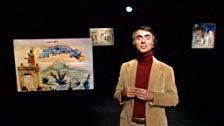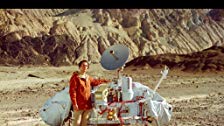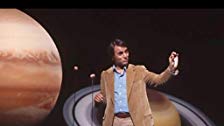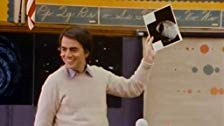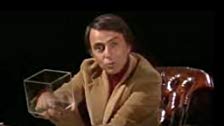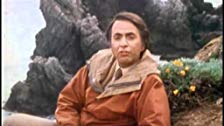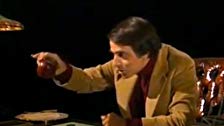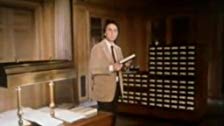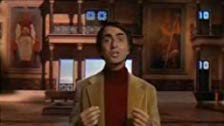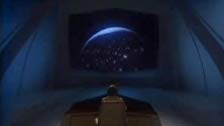Cosmos 1980
As I mentioned on the main Astronomy page, I like this very much, and would recommend it as a good introduction to the history of astronomy and of the history of the universe. I find it holds up pretty well to the 40 years since it’s release, and the edition I got from the library was the 20th anniversary extended edition with updates at the end of most episodes.
I will say, as I have rewatched the series (including the "Updates") and the 2014 remake, I think I can appreciate Carl Sagan better than I ever did before. I've read his wiki and watched some tributes to him, and watching the orginal series I was struck, for the second time, by the beauty of his devotion to the scientific method, in heart and principle. When I look at some of the "Update" segments, I felt he betrayed these ideals, just a little. Maybe that's not fair, it is possible that some of the informaiton about the manipulation of climate data and shouting down of contrary, unpopular opinions was not as developed as it is today. However, I thought I detected his thinking had hardened and he was becoming an advocate rather than simply a Scientist, a pursuer of truth.
When I look at his students, such as Neil deGrasse Tyson and Bill Nye, I see what I believe his colleagues at Harvard were afraid of, and why they pushed the College to deny him tenure. I read that many of them regretted that later, and could see how his popularization of Science was a good for the practice of Science, and indeed for the Country, and maybe the World. But the fear was that he was a self-promoter, stealing other's ideas, and driving an agenda. I believe that is what we see now, that Scientists attempt to drive funding decisions by government and educational institutions to support the causes and beliefs they have. This is anathema to science, which should be the pursuit of truth. I believe young Carl was immune to this, a true idealog for the pursuit of truth. But it is hard, and the longer you live within a community that believes the way you do, and the more you are adored, the stronger the pull to use your popularity. This is what young Carl said, and I why I found him so compelling...
Science is not perfect. It can be misused. It is only a tool. But it is by far the best tool we have, self-correcting, ongoing, applicable to everything. It has two rules.
First: there are no sacred truths; all assumptions must be critically examined; arguments from authority are worthless.
Second: whatever is inconsistent with the facts must be discarded or revised. ... The obvious is sometimes false; the unexpected is sometimes true.
If only we had more men and women like that, how much better place the world would be. All ideas should be able to be uttered, all theories challenged, all data questioned. Science is not consensus, and the better ideas will win out, and scientist and engineers can be relied upon to see the data and draw the logical, rational conclusions.
Comos (1980) - Carl Sagan
This is the general description of the course/series. It's pretty bald for the ground they covered (anti-nuke preaching aside).
Astronomer Carl Sagan leads us on an engaging guided tour of the various elements and cosmological theories of the universe.
Episode 1 The Shores of the Cosmic Ocean 
Carl introduces us to “the ship of the imagination” that will take us on our tour of the universe. He also introduces us to the idea eloquently to the big questions of astronomy. He takes on a brief tour from the middle of the universe back to planet Earth, showing some of the major features of space. He then explains how, Eratosthenes (the chief librarian of Alexandria) derived the circumference of the Earth by a chance reading of the account of the lack of shadows in Syene on the equinox (June 21). He checked this against his observations in Alexandria, which had a shadow, and used the length of the shadow, the distance between the two cities, and calculated the circumference of the globe. He then takes us on a virtual tour of that library, and describes it’s loss before taking us to Kepler and the start of the scientific method, and the understanding of the Heliocentric solar system. Finally he introduces the Universe’s calendar, starting at the Big Bang, up until present time, where the last few minutes of the last day represent the entirety of human history. Good stuff.
Carl Sagan examines our planet's place in the universe by leading us on a journey from Earth to Deep Space.
Episode 2 One Voice in the Cosmic Fugue 
A pretty good episode that describes the building blocks of life, evolution (including a cool Japanese crab, the Heikegani) that has been preferentially saved because it looks like it has a Samurai face in its shell, to experiments at Cornell with the basic gases of the early Earth and how, with electricity, it forms proteins and nucleic acids and the building blocks of life. He closes with a virtual tour of Jupiter’s gases.
Carl Sagan examines the origin, development, and complexity of life on Earth and speculates on the possibility of life developing elsewhere in the universe.
Episode 3 Harmony of the Worlds 
This episode that places the start of the true scientific method, when your preconceived notions are set aside when the evidence doesn’t match. He also discusses the origin of the constellations, and their connection to astrology, and the notice of how regular they are/were - except the planets, the “wanderers”. He then visits the Anasazi and Stonehenge to describe the importance of the stars to early man and to time planting and the harvest. We then move on to Copernicus and the Heliocentric solar system and the explanation of retrograde motion of planets, describing the true motion of the planets. He then describes how Kepler discovered planets follow ellipses with the Sun at one focus - through the use of Tyco Brahe’s outstanding observations, and that the square of the orbital period is proportional to the third power of the radius of it’s orbit.
After briefly looking at the pseudoscience of astrology, Carl Sagan examines the history of astronomy from ancient times through Ptolemy to Johannes Kepler.
Episode 4 Heaven and Hell 
This episode is very good, describing the Tunguska comet event, who’s blast leveled a forest in Russia - without leaving a crater. He then describes Halley’s discovery of the return of the comet named for him - and the superstitions surrounding them with early man. He then relates the excellent story of English (Canterbury) monks seeing, and recording an asteroid strike on the moon, which we can now determine created (Giordano Bruno) crater on the north eastern side of the moon. Finally he describes how difficult it was to take any obersvations of Venus, and introducing absorption spectroscopy - before warning of (ahem) Global Warming.
Carl Sagan examines the nature of comets before turning to a close look at the planet Venus.
Episode 5 Blues for a Red Planet 
A pretty good episode that starts out by describing the War of the Worlds, and the many beliefs people used to hold about Mars. It goes on to chronicle the background and dreams of Robert H. Goddard. Sagan then shows us the Mars survey images of the day, including Olympus Mons and Mariner Valley, and a recap of the images and data from the Viking landers from the late 1970’s.
Carl Sagan looks at the search for life on Mars from the speculations of Percival Lowell and H.G. Wells to the arrival of the Viking probes.
Episode 6 Travellers' Tales
A pretty good show, starting at JPL with the Voyager flight, on the Jupiter fly-bys. It then wanders through the Dutch enlightenment and global exploration, and on to Galileo and timekeeping technology and the quest for longitude. He then introduces us to Christiaan Huygens, and his telescope construction techniques and discoveries. We then learn that Jupiter is a “failed star”, mostly Hydrogen, but just not (a few dozen times too small) big enough to cause nuclear fusion.
Carl Sagan looks at the planets Jupiter and Saturn by examining the work of Galileo, Huygens, and the Voyager probes.
Episode 7 The Backbone of Night 
A OK episode that starts with a bit of Sagan’s hometown of Bensonhurst, NY and a story from his biography about getting an astronomy book about stars. He then recounts the many historical views man had in ancient times about the meaning of the Milky Way in the night sky. We then move to the Greeks like Anaximander and Democritus, and their moves towards science. Sagan then spends a little too much time for my taste explaining the galaxy to a class of what look to be 5th or 6th graders in Brooklyn.
Carl Sagan looks at the work of ancient Greek scientists and astronomers including Thales, Anaximander, Democritus, and Pythagoras.
Episode 8 Journeys in Space and Time 
An pretty good episode. It starts with Carl explaining that everything in the universe is moving, and then showing is how the stars in the constellations are all moving and changing over time. He then explains the speed of light, and how what we see is inevitably something that happened in the past, and often quite some time ago due to the vast distances.
He next explains that light is not only the fastest thing in the universe, but that it is the speed limit of the universe - and the paradox of time dilation. He explains that a light speed space cruiser could accelerate to close to the speed of light for half the trip, and decelerate for the other half, reaching Barnhard’s star in 8 years ship time, the center of the Milky Way in 21 years, and Andromeda in 28 years - but on Earth 30,000 years would have passed. And that we could navigate the known universe in 58 years ships time, but on Earth 10s of billions of years would’ve passed. Then he explores traveling backwards in time.
Carl Sagan explains scientific concepts like relativity and examines the possibility of time travel.
Episode 9 The Lives of the Stars 
Another pretty good episode, it starts with slicing an apple and rolling out dough to make a pie to show subdividing to the atomic level. He then explains the origin of Google, the “Googol” or 10 raised to the power of 100, the answer that mathematician Edward Kasner got from his nephew. Then he walks us through the periodic table of elements, and how atoms are made inside of stars - they shine as they create Helium from Hydrogen.
Towards the middle he describes the lifecycle of stars, how they form as gas, and gravity causes the initial fusion which starts them shining... and how, fuel exhausted, gravity begins to win over the outward nuclear pressures, and the star dies. It dies in one of three ways 1) it collapses until electric forces (into a White Dwarf - the size of the Earth) 2) it collapses until nuclear forces stop it (a Nuetron Star - the size of a City), or 3) it collapses completely into a Black Hole. Next he describes super nova, starting with the Chinese guest star of 1054, the remnant of a Red Giant... and leaving a Nuetron Star or Pulsar.
Carl Sagan examines the life cycle of stars from their creation to their deaths.
Episode 10 The Edge of Forever 
OK episode that starts with a discussion of birth, of people and worlds - or the Universe. What is the Big Bang, and what are it’s ramifications 15 Billion years ago. Spiral galaxies, barred, ring, and elliptical... globular and open clusters... He then moves on to explain Doppler shift and how this demonstrates the expansion of the universe. He then describes how the universe might continually expand, or if there is enough matter that it might oscillate between expansion and contraction, and if so, that no data escapes the big collapse. He closes with radio astronomy, and how it has detected the cosmic background radiation.
Carl Sagan focuses on the origin of the universe by discussing the Big Bang, Galaxies, Dimensions, and the expansion of the universe.
Episode 11 The Persistence of Memory 
Pretty good, but again, not my favorite. There’s a long introductory piece on the songs of whales which, though interesting, is not really astronomy. Then then goes on a somewhat anti-humanist rant about sea noise, and the recaps a lot of what he told us previously about DNA, although the bit about viruses and bacteria is new. Next he moves into the structure of the human brain and their various functions.
Next he goes into a pretty interesting discussion of the evolution of a city like New York, and how the evolution of the bridge and tunnel system mirrors biological evolution. Then onto shared memories, the invention of the library in their many forms.
Carl Sagan examines life on earth discussing genes, DNA, the brain, and human social development.
Episode 12 Encyclopaedia Galactica 
A good episode, that starts off with a discussion of UFOs, in particularly the Betty and Barney Hill case. Sagan then segues to the deciphering of the Egyptian hieroglyphs by Jean-François Champollion. This is all interesting, but is the history of learning about a different civilization and not astronomy, so not my very favorite. He does extrapolate from this to a message from another world, which was interesting. He then moves on to a description of the Drake equation, and the likelihood of there being intelligent life on other worlds.
Carl Sagan examines the possibility extraterrestrial life and discusses his skepticism about UFOs.
Episode 13 Who Speaks for Earth? 
The series finale starts with a telling of the meeting of the Tlingit people of Alaska by Jean François de Galaup, comte de Lapérouse, a Frenchman. He then wanders through a rather preachy anti-nuke commentary that doesn’t hold up very well.
Carl Sagan considers the significance of science and discuss the importance of human survival in the nuclear age.
